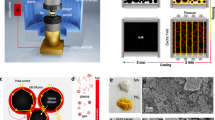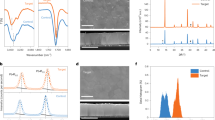Abstract
Despite tremendous progress in efficiency and stability, perovskite solar cells are still facing the challenge of upscaling. Here we present unique advantages of reactive polyiodide melts for solvent- and adduct-free reactionary fabrication of perovskite films exhibiting excellent quality over large areas. Our method employs a nanoscale layer of metallic Pb coated with stoichiometric amounts of CH3NH3I (MAI) or mixed CsI/MAI/NH2CHNH2I (FAI), subsequently exposed to iodine vapour. The instantly formed MAI3(L) or Cs(MA,FA)I3(L) polyiodide liquid converts the Pb layer into a pure perovskite film without byproducts or unreacted components at nearly room temperature. We demonstrate highly uniform and relatively large area MAPbI3 perovskite films, such as 100 cm2 on glass/fluorine-doped tin oxide (FTO) and 600 cm2 on flexible polyethylene terephthalate (PET)/indium tin oxide (ITO) substrates. As a proof-of-concept, we demonstrate solar cells with reverse scan power conversion efficiencies of 16.12% (planar MAPbI3), 17.18% (mesoscopic MAPbI3) and 16.89% (planar Cs0.05MA0.2FA0.75PbI3) in the standard FTO/c(m)-TiO2/perovskite/spiro-OMeTAD/Au architecture.
This is a preview of subscription content, access via your institution
Access options
Access Nature and 54 other Nature Portfolio journals
Get Nature+, our best-value online-access subscription
$29.99 / 30 days
cancel any time
Subscribe to this journal
Receive 12 print issues and online access
$259.00 per year
only $21.58 per issue
Buy this article
- Purchase on Springer Link
- Instant access to full article PDF
Prices may be subject to local taxes which are calculated during checkout






Similar content being viewed by others
Data availability
The data that support the findings of this study are available from the corresponding author upon reasonable request.
References
Kojima, A., Teshima, K., Shirai, Y. & Miyasaka, T. Organometal halide perovskites as visible-light sensitizers for photovoltaic cells. J. Am. Chem. Soc. 131, 6050–6051 (2009).
Yang, W. S. et al. High-performance photovoltaic perovskite layers fabricated through intramolecular exchange. Science 348, 1234–1237 (2015).
NREL Best Research-Cell Efficiencies; https://www.nrel.gov/pv/assets/images/efficiency-chart.png
Saliba, M. et al. Incorporation of rubidium cations into perovskite solar cells improves photovoltaic performance. Science 354, 203–206 (2016).
Chang, N. L. et al. Manufacturing cost and market potential analysis of demonstrated roll-to-roll perovskite photovoltaic cell processes. Sol. Energy Mater. Sol. Cells 174, 314–324 (2018).
Forgács, D. et al. Efficient monolithic perovskite/perovskite tandem solar cells. Adv. Energy Mater. 7, 1602121 (2017).
Guchhait, A. et al. Over 20% efficient CIGS-perovskite tandem solar cells. ACS Energy Lett. 2, 807–812 (2017).
Sahli, F. et al. Fully textured monolithic perovskite/silicon tandem solar cells with 25.2% power conversion efficiency. Nat. Mater. 17, 820–826 (2018).
Shockley, W. & Queisser, H. J. Detailed balance limit of efficiency of p–n junction solar cells. J. Appl. Phys. 32, 510–519 (1961).
Hailegnaw, B., Kirmayer, S., Edri, E., Hodes, G. & Cahen, D. Rain on methylammonium lead iodide based perovskites. Possible environmental effects of perovskite solar cells. J. Phys. Chem. Lett. 6, 1543–1547 (2015).
Tress, W., Correa Baena, J. P., Saliba, M., Abate, A. & Graetzel, M. Inverted current–voltage hysteresis in mixed perovskite solar cells. Polarization, energy barriers, and defect recombination. Adv. Energy Mater. 6, 1600396 (2016).
Leijtens, T. et al. Stability of metal halide perovskite solar cells. Adv. Energy Mater. 5, 1500963 (2015).
Arora, N. et al. Perovskite solar cells with CuSCN hole extraction layers yield stabilized efficiencies greater than 20%. Science 358, 768–771 (2017).
Li, Z. et al. Scalable fabrication of perovskite solar cells. Nat. Rev. Mater. 3, 18017 (2018).
Di Giacomo, F. et al. Up-scalable sheet-to-sheet production of high efficiency perovskite module and solar cells on 6-in. substrate using slot die coating. Sol. Energy Mater. Sol. Cells 181, 53–59 (2018).
Yang, M. et al. Perovskite ink with wide processing window for scalable high-efficiency solar cells. Nat. Energy 2, 17038 (2017).
Heo, J. H., Lee, M. H., Jang, M. H. & Im, S. H. Highly efficient CH3NH3PbI3−xClx mixed halide perovskite solar cells prepared by redissolution and crystal grain growth via spray coating. J. Mater. Chem. A 4, 17636–17642 (2016).
Zhou, Y., Game, O. S., Pang, S. & Padture, N. P. Microstructures of organometal trihalide perovskites for solar cells. Their evolution from solutions and characterization. J. Phys. Chem. Lett. 6, 4827–4839 (2015).
Cotella, G. et al. One-step deposition by slot-die coating of mixed lead halide perovskite for photovoltaic applications. Sol. Energy Mater. Sol. Cells 159, 362–369 (2017).
Schmidt, T. M., Larsen-Olsen, T. T., Carlé, J. E., Angmo, D. & Krebs, F. C. Upscaling of perovskite solar cells. Fully ambient roll processing of flexible perovskite solar cells with printed back electrodes. Adv. Energy Mater. 5, 1500569 (2015).
Das, S. et al. High-performance flexible perovskite solar cells by using a combination of ultrasonic spray-coating and low thermal budget photonic curing. ACS Photonics 2, 680–686 (2015).
Yang, Z. et al. High-performance fully printable perovskite solar cells via blade-coating technique under the ambient condition. Adv. Energy Mater. 5, 1500328 (2015).
Liu, J. et al. Improved crystallization of perovskite films by optimized solvent annealing for high efficiency solar cell. ACS Appl. Mater. Interfaces 7, 24008 (2015).
Yang, M. et al. Facile fabrication of large-grain CH3NH3PbI3−xBrx films for high-efficiency solar cells via CH3NH3Br-selective Ostwald ripening. Nat. Commun. 7, 12305 (2016).
Matsui, T., Seo, J.-Y., Saliba, M., Zakeeruddin, S. M. & Grätzel, M. Room-temperature formation of highly crystalline multication perovskites for efficient, low-cost solar cells. Adv. Mater. 29, 1606258 (2017).
Raga, S. R., Jiang, Y., Ono, L. K. & Qi, Y. Application of methylamine gas in fabricating organic–inorganic hybrid perovskite solar cells. Energy Technol. 5, 1750–1761 (2017).
Zhou, Y. & Padture, N. P. Gas-induced formation/transformation of organic–inorganic halide perovskites. ACS Energy Lett. 2, 2166–2176 (2017).
Zhao, T. et al. Design rules for the broad application of fast ( < 1 s) methylamine vapor based, hybrid perovskite post deposition treatments. RSC Adv. 6, 27475 (2016).
Singh, A., Chouhan, A. S. & Avasthi, S. Methylamine vapor exposure for improved morphology and stability of cesium-methylammonium lead halide. Preprint at https://arXiv.org/abs/1712.09068 (2017).
Chen, H. et al. A solvent- and vacuum-free route to large-area perovskite films for efficient solar modules. Nature 550, 92–95 (2017).
Zhou, Y., Yang, M., Pang, S., Zhu, K. & Padture, N. P. Exceptional morphology-preserving evolution of formamidinium lead triiodide perovskite thin films via organic-cation displacement. J. Am. Chem. Soc. 138, 5535–5538 (2016).
Ávila, J., Momblona, C., Boix, P. P., Sessolo, M. & Bolink, H. J. Vapor-deposited perovskites. The route to high-performance solar cell production?. Joule 1, 431–442 (2017).
Leyden, M. R. et al. High performance perovskite solar cells by hybrid chemical vapor deposition. J. Mater. Chem. A 2, 18742 (2014).
Remeika, M. & Qi, Y. Scalable solution coating of the absorber for perovskite solar cells. J. Energy Chem. 27, 1101–1110 (2018).
Zhou, Y. & Zhu, K. Perovskite solar cells shine in the “Valley of the Sun”. ACS Energy Lett. 1, 64–67 (2016).
Lee, J.-W. & Park, N.-G. Two-step deposition method for high-efficiency perovskite solar cells. MRS. Bull. 40, 654–659 (2015).
Bengtsson, L. A., Stegemann, H., Holmberg, B. & Füllbier, H. The structure of room temperature molten polyiodides. Mol. Phys. 73, 283–296 (1991).
Petrov, A. A. et al. A new formation strategy of hybrid perovskites via room temperature reactive polyiodide melts. Mater. Horiz. 4, 625–632 (2017).
Wang, S., Jiang, Y., Juarez-Perez, E. J., Ono, L. K. & Qi, Y. Accelerated degradation of methylammonium lead iodide perovskites induced by exposure to iodine vapour. Nat. Energy 2, 16195 (2016).
Rakita, Y., Gupta, S., Cahen, D. & Hodes, G. Metal to halide perovskite (HaP): an alternative route to HaP coating, directly from Pb(0) or Sn(0) films. Chem. Mater. 29, 8620–8629 (2017).
Zhang, W. et al. Ultrasmooth organic–inorganic perovskite thin-film formation and crystallization for efficient planar heterojunction solar cells. Nat. Commun. 6, 6142 (2015).
Shi, D. et al. Low trap-state density and long carrier diffusion in organolead trihalide perovskite single crystals. Science 347, 519–522 (2015).
Dong, Q. et al. Electron–hole diffusion lengths > 175 μm in solution-grown CH3NH3PbI3 single crystals. Science 347, 967–970 (2015).
Saliba, M. et al. Cesium-containing triple cation perovskite solar cells. Improved stability, reproducibility and high efficiency. Energy Environ. Sci. 9, 1989–1997 (2016).
Nie, W. et al. The effect of light soaking on the lattice change and the impact towards long-term photo-stability in Cs doped FA-MAPbI3 mixed cation perovskite alloys. In 3rd International Conference on Perovskite Solar Cells and Optoelectronics (PSCO-2017) A02.02 (2017).
Tang, Z. et al. Hysteresis-free perovskite solar cells made of potassium-doped organometal halide perovskite. Sci. Rep. 7, 12183 (2017).
Giordano, F. et al. Enhanced electronic properties in mesoporous TiO2 via lithium doping for high-efficiency perovskite solar cells. Nat. Commun. 7, 10379 (2016).
Correa Baena, J. P. et al. Highly efficient planar perovskite solar cells through band alignment engineering. Energy Environ. Sci. 8, 2928–2934 (2015).
Anaraki, E. H. et al. Low-temperature Nb-doped SnO2 electron-selective contact yields over 20% efficiency in planar perovskite solar cells. ACS Energy Lett. 3, 773–778 (2018).
Shin, S. S. et al. Colloidally prepared La-doped BaSnO3 electrodes for efficient, photostable perovskite solar cells. Science 356, 167–171 (2017).
Acknowledgements
N.A.B., A.A.P., A.Yu.G., S.A.F., E.A.G. and A.B.T. acknowledge financial support from the Ministry of Education and Science of the Russian Federation, Project Number: RFMEFI60716X0147 and JSC “Krasnoyarskaya HPP”. I.T, S. Kazaoui, S.A. and T.U. acknowledge the support of the New Energy Development Organization of Japan. I.T. and S. Kazaoui thank Hiroshi Tomiyasu, Eisuke Ito (CEREBA) and Tetsuo Tsutsui (Kyushu University) for assistance. I.T. expresses gratitude to Anna Pavlova for her support.
Author information
Authors and Affiliations
Contributions
I.T. conceived the idea of the present work in discussion with A.B.T. Fabrication and characterization of perovskite solar cells and films by the RP-MAGIC method were conducted by I.T., S. Kazaoui and A.B.T. The Pb/MAI interface modification method was developed by S. Kosar through overlapped evaporation. S.A. and T.U. contributed to experiment preparation. N.A.B. and A.Yu.G. developed the spray-assisted RP-MAGIC method. S.A.F. and A.A.P. measured the melting temperatures of polyiodides. E.A.G. measured Raman spectra. I.T., S. Kazaoui, A.B.T., E.A.G., M.K. and M.G. performed scientific evaluation of the data. The manuscript was written by I.T., E.A.G., S. Kazaoui, S. Kosar, A.B.T. and M.G. The project was planned, directed and supervised by I.T. and A.B.T. All the authors discussed the results and commented on the manuscript.
Corresponding author
Ethics declarations
Competing interests
The authors declare no competing interests.
Additional information
Publisher’s note: Springer Nature remains neutral with regard to jurisdictional claims in published maps and institutional affiliations.
Supplementary information
Supporting information
Supplementary text and Supplementary Figs. 1–16
Supplementary Video 1
Fabrication of large area MAPbI3 film on flexible PET/ITO substrate
Supplementary Video 2
Conversion of the Pb/MAI bilayer into MAPbI3 with a crystallite of iodine as iodine source
Rights and permissions
About this article
Cite this article
Turkevych, I., Kazaoui, S., Belich, N.A. et al. Strategic advantages of reactive polyiodide melts for scalable perovskite photovoltaics. Nature Nanotech 14, 57–63 (2019). https://doi.org/10.1038/s41565-018-0304-y
Received:
Accepted:
Published:
Issue Date:
DOI: https://doi.org/10.1038/s41565-018-0304-y
This article is cited by
-
Scalable fabrication and coating methods for perovskite solar cells and solar modules
Nature Reviews Materials (2020)
-
Performance improvement of perovskite solar cells via spiro-OMeTAD pre-crystallization
Journal of Materials Science (2020)
-
A chain-type diamine strategy towards strongly anisotropic triiodide of DMEDA·I6
Science China Materials (2020)



